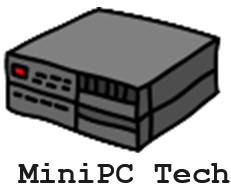What happens When You Integrate a Raspberry Pi In IoT Ecosystems?
When you integrate Raspberry Pi into IoT ecosystems, you gain a flexible foundation for scalable, device-driven networks. You’ll see that it accommodates diverse protocols, sensor arrays, and automation logic without straining your budget or infrastructure. By aligning hardware interfaces with reliable software tools, you can streamline edge processing and data flow. Yet, aligning these elements for consistent, secure operations introduces unique design challenges you need to anticipate…
Key Takeaways
- Raspberry Pi supports multiple connectivity options (Wi-Fi, Ethernet, Bluetooth) for seamless integration with diverse IoT devices and cloud services.
- Its GPIO pins and protocol support (I2C, SPI) enable direct sensor and actuator connections for flexible automation and monitoring tasks.
- Extensive community support and Python libraries simplify development, device integration, and troubleshooting within IoT projects.
- Lightweight operating systems and headless operation allow scalable, cost-effective deployments in smart homes, industry, and agriculture.
- Built-in network security features such as SSH authentication and encrypted communications protect IoT data and device integrity.
Exploring the Benefits of Integrating Raspberry Pi Into IoT Systems
While integrating devices into IoT ecosystems demands flexibility and efficiency, Raspberry Pi stands out by delivering cost-effective, capable hardware for scalable solutions.
You’ll discover that its affordability and low power consumption greatly reduce deployment costs, making it ideal for innovators planning diverse Raspberry Pi applications or prototyping IoT project ideas. Thanks to its compatibility with a wide range of IoT sensors and peripherals, Raspberry Pi simplifies integration and accelerates the development of complex IoT projects.
Multiple connectivity options, including Wi-Fi, Bluetooth, and Ethernet, allow seamless communication between sensors and networks. GPIO pins facilitate easy integration of actuators and custom peripherals, expanding application range. The latest models offer impressive processing capabilities for real-time monitoring and automation, making them suitable for both home and industrial IoT applications.
Diverse connectivity and easy GPIO integration make Raspberry Pi exceptionally versatile for linking sensors, networks, and custom IoT components.
Raspberry Pi can locally process data for responsive edge computing—vital when low latency matters. The Linux-based environment guarantees robust development flexibility, supporting Python, C++, and open-source tools for rapid iteration.
This empowers you to create innovative, secure, and adaptable IoT architectures without exceeding budget constraints.
Selecting the Optimal Raspberry Pi Model for Your Project
When selecting a Raspberry Pi for your IoT project, you’ll need to balance system cost against the required performance and resource footprint.
Evaluate your processing needs and expected compute loads to choose a model that matches your project’s scalability goals. When deciding between models, it helps to consider their form factor and feature differences—for instance, the flagship, Zero, Compute Module, and Pico series each offer unique sizes and hardware capabilities suited to distinct types of applications.
Assess connectivity options, ensuring your selection supports all necessary interfaces for successful peripheral integration. Many modern Raspberry Pi models offer extensive community support, so you can leverage shared knowledge and troubleshooting resources during your development.
Balancing Cost and Performance
Selecting the ideal Raspberry Pi model for your IoT project requires weighing both cost and performance factors to align with your specific application needs and scalability goals.
Achieve cost efficiency by matching device capabilities to workload demands. For simple sensor networks, Pi Zero models minimize expense and power use, supporting basic cost efficiency. The growing market for Raspberry Pi highlights its increasing popularity among businesses and tech enthusiasts, making it essential to consider both performance and future support when selecting a model.
When your ecosystem needs higher throughput or advanced analytics, Raspberry Pi 4 hits a sweet spot—balancing price and versatile performance optimization, while Raspberry Pi 5’s premium is justified for AI/ML, multi-sensor fusion, or edge computing. Ram capacity plays a critical role, as higher-RAM models like Pi 4 and Pi 5 are favored for managing multiple devices and enabling efficient multitasking in home automation systems.
Factor in the costs of RAM, storage, and power supplies, since scalable design often depends on modular upgrades.
Prioritize models with expandable storage if future-proofing and system resilience drive long-term value in your deployment.
Assessing Processing Requirements
Achieving the right cost-performance balance for your IoT deployment sets the stage for a deeper look at processing requirements. When selecting the best Raspberry Pi model, analyze your project’s demand for processing power and memory requirements.
Simple sensor-monitoring systems can run on the Raspberry Pi Zero, leveraging low power consumption. For tasks like real-time video processing, edge computing, or machine learning, the Raspberry Pi 4’s quad-core CPU and up to 8 GB RAM deliver scalable performance. Advanced applications often depend on the Pi’s ability to provide both plentiful GPIO and socket connections for seamless integration with IoT services.] Consider that many IoT use cases benefit from GPIO and IoT libraries that are readily supported on Raspberry Pi platforms, making integration and development more straightforward.
Memory requirements escalate rapidly with multi-tasking, large datasets, or real-time analytics—demanding robust RAM to maintain stability. Evaluate task complexity before choosing: advanced automation or industrial IoT typically warrants the higher capacity of the Raspberry Pi 4 or 5.
Matching these factors guarantees your deployment is both efficient and future-ready.
Factoring Connectivity Options
Connectivity is a cornerstone of robust IoT design, and Raspberry Pi models offer a range of integrated and extensible options to address diverse deployment scenarios.
For wireless projects, leveraging Wi Fi advantages—mobility and simplified infrastructure—enables rapid, scalable node deployment. If you require deterministic communication or need to anchor a central hub, Ethernet stability guarantees consistent data throughput and low latency. Battery-powered IoT devices often utilize protocols and hardware optimized for low energy consumption, enabling months-long operation without frequent maintenance.
Bluetooth applications excel for energy-efficient, short-range IoT sensor links, particularly with BLE enabling months-long battery operation. Increasingly, Edge computing functions can be performed directly on the Raspberry Pi, allowing preliminary data filtering and aggregation before transmission to the cloud, which reduces overall network load and latency. For mesh or long-range use cases, Zigbee integration and LoRaWAN options are available via HATs or USB dongles, offering versatile protocol support beyond native capabilities.
Select the Raspberry Pi Zero W for lightweight, low-power deployments, or use Raspberry Pi 4/5 when multi-protocol scalability and high bandwidth are critical.
Key IoT Applications Powered by Raspberry Pi
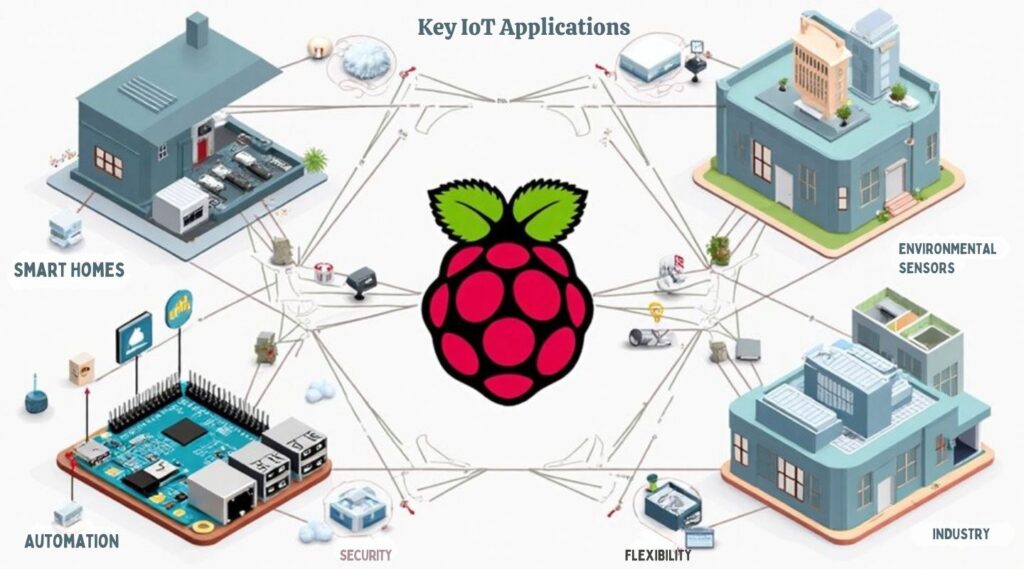
You can leverage Raspberry Pi as a scalable foundation for smart home control, industrial data monitoring, and automated agriculture solutions.
Its modular architecture lets you integrate sensors, actuators, and diverse protocols to address each domain’s specific requirements. This adaptability allows Raspberry Pi to act as the backbone for various innovative projects across multiple industries by supporting different hardware and software configurations.
In addition, Raspberry Pi serves as a powerful microcomputer for IoT applications, making it an accessible choice for developers and makers alike.
Smart Home Control
When leveraging the Raspberry Pi for smart home control, the platform brings together robust hardware, flexible software ecosystems, and scalable integrations, making it a cornerstone of modern IoT-enabled living environments.
Beyond its connectivity features, Raspberry Pi supports a rich variety of smart home software such as Home Assistant, OpenHAB, and Mycroft, giving users broad options for automation and voice control.
Embracing smart home trends, you’ll deploy a Raspberry Pi 4—optimized for seamless automation strategies—paired with Home Assistant, which supports both wired networking and expansive device integrations.
You can unify diverse devices—Philips Hue lighting, Zigbee or Z-Wave modules, Sonos speakers, and smart plugs—while utilizing GPIO pins for sensor connectivity, driving system-oriented reliability.
Notably, Home Assistant operates headless, meaning that during the setup and daily operation, you do not need to connect a monitor or keyboard to your Raspberry Pi, simplifying installation and placement in your home.
Advanced tools like Node-RED and IFTTT streamline workflow automation, while custom dashboards through Lovelace empower real-time control and monitoring.
Integrating voice assistants further elevates user interaction, futureproofing your design with modularity and innovation at its core.
Industrial Data Monitoring
While Raspberry Pi excels in orchestrating smart home environments, its capabilities scale efficiently to address the rigorous demands of industrial data monitoring.
You can deploy Raspberry Pi applications to capture real-time data from sensors and machinery, facilitating continuous industrial data analysis at the edge. With its robust data logging features, Raspberry Pi guarantees key events are tracked and anomalies are flagged immediately, enabling predictive maintenance routines that reduce unplanned downtime. A new quarterly newsletter focused on Raspberry Pi for industrial applications keeps businesses informed about the latest innovations, helping organizations maximize the value of their monitoring solutions.
Additionally, Raspberry Pi has proven effective for automating manual factory record-keeping by directly logging sensor-triggered events—such as machine cycles or tool checks—thus minimizing human error and ensuring uninterrupted, round-the-clock data gathering.
Integrating with process control systems, it features PLC-like flexibility and custom HMI dashboards for operator insight. Edge computing reduces latency by processing data locally, while built-in connectivity supports seamless remote monitoring, instant alerts, and secure transmission of analytics-ready data to central management systems.
Raspberry Pi delivers scalable, programmable, and innovative industrial monitoring solutions.
Automated Agriculture Solutions
As agriculture confronts the dual challenges of sustainability and scalability, deploying Raspberry Pi-based IoT systems has emerged as a transformative approach to farm automation.
By integrating precision monitoring, you can track real-time environmental variables—temperature, humidity, and soil moisture—across your fields, enabling proactive crop health and pest detection. The versatility and affordability of Raspberry Pi devices makes advanced monitoring technology more accessible to farmers worldwide, expanding the reach of precision agriculture.
Raspberry Pi serves as the main controlling unit for managing data from various connected sensors, ensuring seamless automation and monitoring across the farm.
Automated irrigation leverages soil moisture sensors with centralized control, optimizing water delivery and minimizing waste.
For robust soil management, connect pH and nutrient sensors to continuously assess and adjust soil conditions, supporting targeted fertilizer application and sustainable practices.
Data analytics aggregate sensor feedback, allowing you to implement dynamic interventions and optimize resources.
With edge computing and cloud integration, your automated agriculture solution achieves both modular scalability and advanced, data-driven farm management—pushing operational efficiency and yield to new heights.
Step-by-Step Setup of Raspberry Pi for IoT Deployment
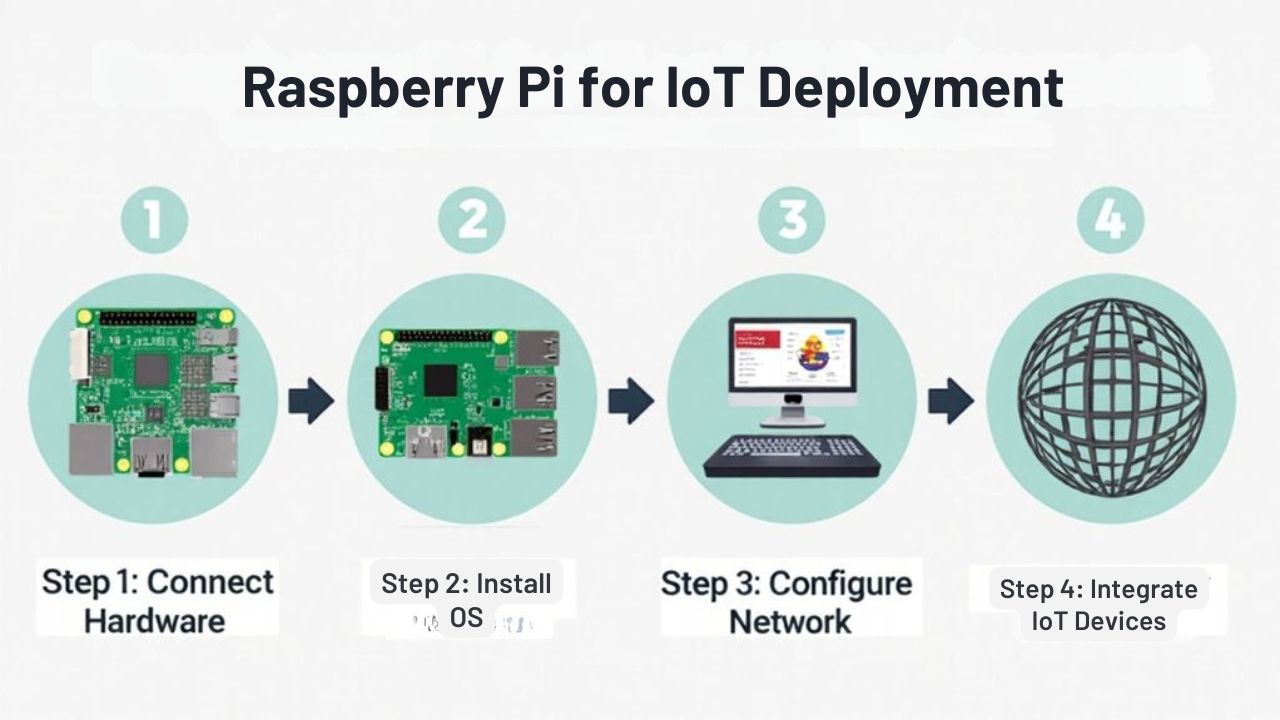
Before deploying a Raspberry Pi within an IoT ecosystem, you need to establish a robust and repeatable setup process that guarantees consistency and security across devices.
Start with tailored hardware configuration by selecting a suitable Raspberry Pi model and assembling core peripherals. Confirm your microSD hosts the latest Raspberry Pi OS, using trusted tools for software installation. Connect the board to a monitor for direct setup, or configure for headless IoT deployment if needed. By following basic IoT tutorials with Raspberry Pi, even beginners can set up hardware and software to control physical devices like LEDs over a network. To ensure seamless network connectivity, it’s important to connect your Raspberry Pi to Ethernet or configure the WiFi settings during the operating system setup stage.
For a streamlined process, follow these steps:
- Select hardware and assemble peripherals for targeted scale.
- Install Raspberry Pi OS and complete initial configuration, confirming network readiness.
- Update software, enable required services like SSH/VNC, and implement network security policies.
- Install mission-critical libraries, interfaces, and IoT-relevant packages, finalizing software installation for deployment readiness.
Integrating Sensors and Actuators With Raspberry Pi
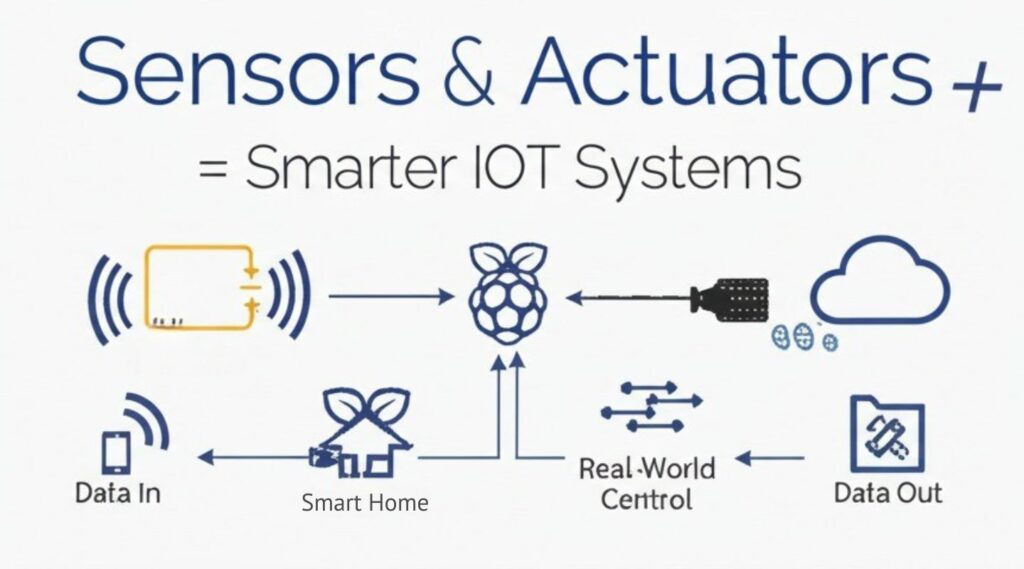
Once you’ve prepared your Raspberry Pi for deployment, integrating sensors and actuators becomes a core step in constructing a functional IoT node.
Start by selecting between I2C or SPI based on protocol selection requirements—use I2C for multi sensor setup and SPI when high-speed actuator control is needed.
Adhere strictly to wiring best practices: match power levels (3.3V/5V), guarantee stable connections, and reference GPIO pinouts to prevent damage.
Prioritize power management to minimize electrical noise and avoid data errors.
Leverage Python libraries such as SMBus and spidev for streamlined library utilization, expediting data acquisition and sensor calibration tasks.
For each device, consult documentation to configure unique addresses or chip selects.
This modular integration approach guarantees scalable, robust design within advanced IoT ecosystems.
Establishing Wireless Connectivity and Remote Access

While integrating a Raspberry Pi into your IoT ecosystem, establishing reliable wireless connectivity and enabling remote access are essential for scalable, system-oriented design.
You’ll leverage built-in Wi-Fi and Bluetooth, or deploy external modules (Bluetooth, Zigbee, LoraWAN) to address range and connectivity requirements.
Carefully select wireless protocols—such as MQTT, BLE, Zigbee, or LoraWAN—based on your application’s scalability and power constraints.
Choose MQTT, BLE, Zigbee, or LoraWAN protocols with careful attention to your system’s scale and power efficiency needs.
For remote management, utilize SSH for secure command-line control and VNC or web interfaces for thorough system administration.
Consider these foundational steps:
- Configure robust wireless protocols to optimize device intercommunication.
- Set up SSH or VNC for seamless, secure remote management.
- Deploy integration platforms (Node-RED, Homeassistant) to streamline scalable control flows.
- Monitor network health and guarantee stable, interference-free connectivity.
Securing Iot Devices and Networks With Raspberry Pi

Although Raspberry Pi excels as a flexible IoT platform, securing both the devices and their network integrations is essential for any production-grade deployment. Start by enforcing device authentication—replace default credentials, use SSH key authentication, and consider 2FA for elevated assurance. Automate firmware updates and align with compliance standards, reducing software vulnerabilities. Encrypt all data at rest and in transit with modern encryption strategies like LUKSv2 and dTLS. Leverage network segmentation and firewalls, restricting the Pi’s reach within your infrastructure. Guard against physical tampering with hardware controls and asset tracking. Implement strict access controls and monitor system logs for anomalies, establishing robust logging practices.
| Security Aspect | Recommended Action | Benefit |
|---|---|---|
| Authentication | Key-based SSH, 2FA | Lowers unauthorized access |
| Firmware Updates | Automate & schedule | Patches vulnerabilities |
| Network Segmentation | VLANs, firewalls | Limits attack surface |
| Encryption | LUKSv2, dTLS protocols | Protects data confidentiality |
| Physical Security | Port locks, tracking | Mitigates hardware compromises |
Leveraging Educational Resources and Community Support
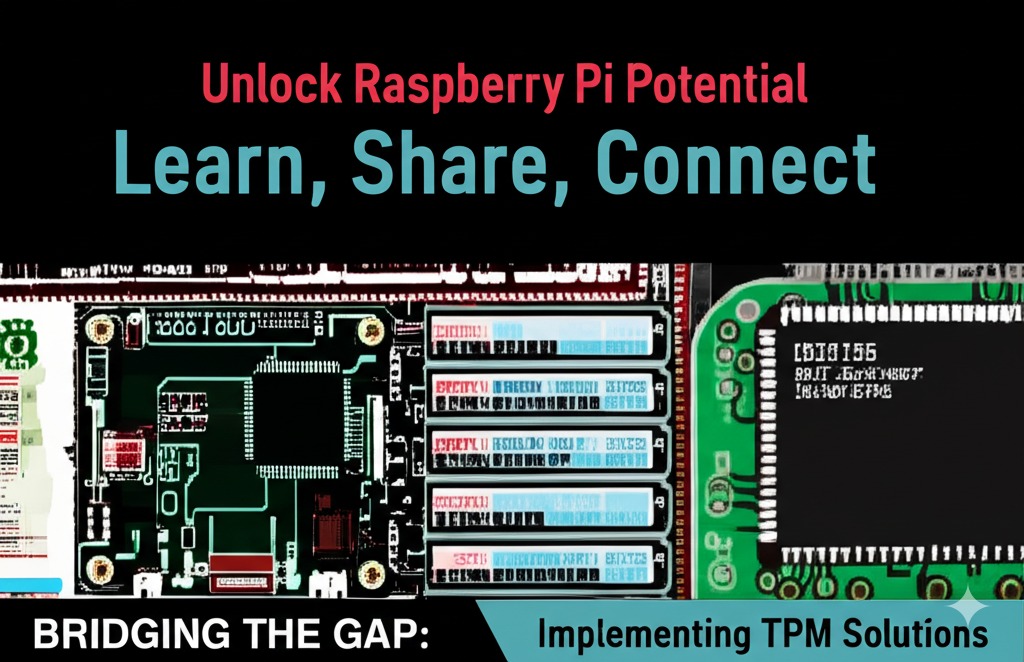
As you build and scale IoT solutions with Raspberry Pi, tapping into robust educational resources and dynamic community support dramatically accelerates both your technical competency and project efficiency.
Effective curriculum development, like the open-source “IoT for Beginners” course and Raspberry Pi Foundation’s learning pathways, guarantees a structured progression from sensor integration to cloud-based automation.
Structured curriculum—from integrating sensors to mastering cloud automation—ensures your IoT skills grow efficiently and comprehensively with each step.
Community engagement provides continuous feedback, innovative insights, and collaborative problem-solving through events, code clubs, and active forums.
Leverage these system-oriented resources for scalable IoT design:
- Explore extensive guides and hands-on labs from open-source curricula.
- Join community events—like Coolest Projects—and showcase your solutions.
- Engage in online forums and GitHub repositories for real-time support.
- Collaborate in code clubs to refine both software and hardware competencies.
This synergy drives innovation and sustainable impact.
Frequently Asked Questions
How Can Raspberry Pi Handle Firmware Updates in Deployed Iot Devices?
You deploy, monitor, and secure Raspberry Pi devices efficiently by using over the air updates, applying robust version control, and implementing A/B partitions—ensuring seamless rollbacks, automated patching, and scalable, resilient firmware management for your innovative IoT deployments.
What Are Best Practices for Power Supply and Battery Backup for Raspberry Pi Iot Setups?
You should prioritize stable power consumption by choosing regulated 5V supplies with safety certifications, robust cables, and adequate amperage. Optimize power management using battery backup solutions, overflow buffers, and monitoring tools for adaptable, scalable, and innovative project design.
How Do You Migrate Data From Raspberry Pi to Enterprise-Scale Databases?
You leverage data synchronization techniques like automated ETL scripts and secure database connection protocols—SSH tunneling or VPN—to transfer data. Validate integrity with row counts and checksums, ensuring schema alignment for seamless migration to enterprise-scale databases.
Can Raspberry Pi Run Real-Time Operating Systems for Time-Critical IoT Applications?
Imagine process and precision aligning—you can achieve real time performance on Raspberry Pi by leveraging RT patches or alternative RTOS, but you’ll need careful operating system compatibility checks and hardware tweaks for truly scalable, deterministic designs.
How Do You Manage Multiple Raspberry Pi Devices in a Large-Scale Iot Deployment?
You should use scalable management platforms and automation tools like Ansible to streamline deployment and updates. Prioritize continuous device monitoring, enforce network security best practices, and automate alerts to guarantee resilient, efficient control across your growing Raspberry Pi fleet.
Conclusion
As you integrate Raspberry Pi into your IoT solution, remember that over 40% of IoT prototypes worldwide leverage this platform for rapid deployment and scalability. By carefully selecting the right model, ensuring robust wireless connectivity, and following best wiring practices, you’ll create secure, future-ready systems. Combine this technical precision with community resources, and you’ll reveal efficient, scalable designs that keep your IoT networks resilient and adaptable in an ever-evolving technological landscape.

I am a retired software engineer with experience in a multitude of areas including managing AWS and VMWare development environments. I bought a relative a mini-PC a year ago and have become passionate about the technology and its potential to change how we deploy software.
